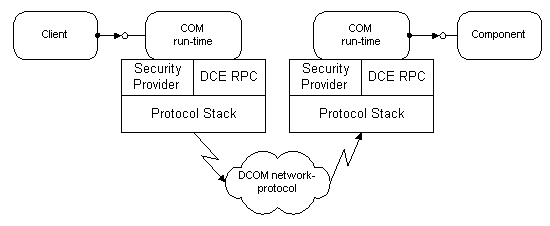
DCOM is an extension of the Component Object Model (COM). COM defines how components and their clients interact. This interaction is defined such that the client and the component can connect without the need of any intermediary system component. The client calls methods in the component without any overhead whatsoever. Figure 1 illustrates this in the notation of the Component Object Model:

Figure 1 - COM Components in the same process
In today's operating systems, processes are shielded from each other. A client that needs to communicate with a component in another process cannot call the component directly, but has to use some form of inter-process communication provided by the operating system. COM provides this communication in a completely transparent fashion: it intercepts calls from the client and forwards them to the component in another process. Figure 2 illustrates how the COM/DCOM run-time libraries provide the link between client and component.

Figure 2 - COM Components in different processes
When client and component reside on different machines, DCOM simply replaces the local Inter-process communication with a network protocol. Neither the client nor the component are aware that the wire that connects them has just become a little longer.
Figure 3 shows the overall DCOM architecture: The COM run-time provides object-oriented services to clients and components and uses RPC and the security provider to generate standard network packets that conform to the DCOM wire-protocol standard.

Figure 3 - DCOM: COM Components on different machines